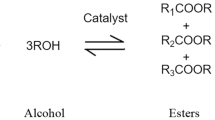Abstract
The increasing application of biobased lubricants could significantly reduce environmental pollution and contribute to the replacement of petroleum base oils. Vegetable oils are recognized as rapidly biodegradable and are thus promising candidates for use as base fluids in formulation of environment friendly lubricants. Although many vegetable oils have excellent lubricity, they often have poor oxidation and low temperature stability. Here in, we report the lubricant potential of Moringa oil, which has 74% oleic acid content and thus possess improved oxidation stability over many other natural oils. For comparison, Jatropha oil, cottonseed oil, canola oil and sunflower oil were also studied. Among these oils, Moringa oil exhibits the highest thermo-oxidative stability measured using PDSC and TG. Canola oil demonstrated superior low temperature stability as measured using cryogenic DSC, pour point and cloud point measurements. The friction and wear properties were measured using HFRR. Overall, it was concluded that Moringa oil has potential in formulation of industrial fluids for high temperature applications.




Similar content being viewed by others
References
Horner D. Recent trends in environmentally friendly lubricants. J Synth Lubr. 2002;18:327–47.
Gawrilow I. Vegetable oil usage in lubricants. INFORM—Int News Fats. Oils Relat Mater. 2004;15:702–5.
Bergstra R. Green means go. Lubes-n-Greases. 2004;10:36–42.
Rudnick LR, Shubkin RL. Synthetic lubricants and high-performance functional fluids, 2nd ed. New York: Marcel Dekker Inc.; 1999.
Becker R, Knorr A. An evaluation of antioxidants for vegetable oils at elevated temperatures. Lubr Sci. 1996;8:95–117.
Rhodes BN, Mammel W, Landis P, Erickson FL. Water rejection of vegetable oil base stocks for tractor/hydraulic fluids. Society of Automotive Engineers Technical Paper 952073. 1995;1–4.
Asadauskas S, Perez JM, Duda JL. Oxidative stability and antiwear properties of high oleic vegetable oils. Lubr Eng. 1996;5:877–82.
Morton JF. The horseradish tree, Moringa pterigosperma (Moringaceae). A boon to arid lands. Econ Bot. 1991;45:318–33.
Anwar F, Ashraf M, Bhanger MI. Interprovenance variation in the composition of Moringa oleifera oilseeds from Pakistan. J Am Oil Chem Soc. 2005;82:45–51.
Anwar F, Latif S, Ashraf M, Gilani AH. Moringa oleifera: a food plant with multiple medicinal uses. Phytother Res. 2007;21:17–25.
Anon. editor. The wealth of India: raw materials, vol. 6:L-M, India: Council of Scientific and Industrial Research, New Delhi; 1962. p. 425–9.
Sengupta A, Gupta MP. Studies on the seed fat composition of Moringaceae family. Fette, Seifen, Anstrichmitte. 1970;72:6–10.
Anwar F, Bhanger MI. Analytical characterization of Moringa oleifera seed oil grown in temperate regions of Pakistan. J Agric Food Chem. 2003;51:6558–63.
Somali MA, Bajnedi MA, Al-Fhaimani SS. Chemical composition and characteristics of Moringa peregrina seeds and seeds oil. J Am Oil Chem Soc. 1984;61:85–6.
Lalas S, Tsaknis J. Extraction and identification of natural antioxidant from the seeds of the Moringa oleifera tree variety of Malawi. J Am Oil Chem Soc. 2002;79:677–83.
Azam MM, Waris A, Nahar NM. Properties and potential of fatty acid methyl esters of some non-traditional seed oils for use as biodiesel in India. Biomass Bioenergy. 2005;29:293–302.
Rashid U, Anwar F, Moser BR, Knothe G. Moringa oleifera oil: a possible source of biodiesel. Bioresour Technol. 2008;99:8175–9.
Kodali DR. Oxidative stability measurement of high-stability oils by pressure differential scanning calorimeter (PDSC). J Agric Food Chem. 2005;53:7649–53.
Santos JCO, Oliveira AD, Silva CC, Silva JDS, Souza AG, Lima LN. Kinetic and activation thermodynamic parameters on thermal decomposition of synthetic lubricant oils. J Therm Anal Calorim. 2007;87:823–9.
Santos JCO, Lima LN, Santos IMG, Souza AG. Thermal, spectroscopic and rheological study of mineral base lubricating oils. J Therm Anal Calorim. 2007;87:639–43.
Garcia CC, Franco PIBM, Zuppa TO, Filho NRA, Leles MIG. Thermal stability studies of some cerrado plant oils. J Therm Anal Calorim. 2007;87:645–8.
Vecchio S, Campanella L, Nuccilli A, Tomassetti M. Kinetic study of thermal breakdown of triglycerides contained in extra-virgin olive oil. J Therm Anal Calorim. 2008;91:51–6.
Lin B, Yang L, Dai H, Hou Q, Zhang L. Thermal analysis of soybean oil based polyols. J Therm Anal Calorim. 2009;95:977–83.
Gonçalves MLA, Ribeiro DA, da Mota DAP, Teixeira AMRF, Teixeira MAG. Investigation of petroleum medium fractions and distillation residues from Brazilian crude oils by thermogravimetry. Fuel. 2006;85:1151–5.
Imahara H, Minami E, Saka S. Thermodynamic study on cloud point of biodiesel with its fatty acid composition. Fuel. 2006;85:1666–70.
Yang L, Dai H, Yi A, Lin B, Li G. Structure and properties of partially epoxidized soybean oil. J Therm Anal Calorim. 2008;93:875–9.
Gunstone FD. Fatty acid and lipid chemistry. Maryland: Aspen Publishers Inc.; 1999. p. 101–37.
Noordin M, Chung L. Thermostability and polymorphism of theobroma oil and palm kernel oil as suppository bases. J Therm Anal Calorim. 2009;95:891–4.
Lutton ES, Fehl AJ. The polymorphism of odd and even saturated single acid triglycerides. Lipids. 1970;5:90–9.
Hagemann JW, Rothfus JA. Polymorphism and transformation energetics of saturated monoacid triglycerides from differential scanning calorimetry and theoretical modeling. J Am Oil Chem Soc. 1983;60:1123–31.
Sato K. Crystallization behavior of fats and lipids—a review. Chem Eng Sci. 2001;56:2255–65.
Cebula DJ, Smith KW. Differential scanning calorimetry of confectionery fats. Pure triglycerides. Effects of cooling and heating rate variation. J Am Oil Chem Soc. 1991;68:591–5.
Hagemann JW, Tallent WH, Kolb KE. Differential scanning calorimetry of single acid triglycerides: effect of chain length and unsaturation. J Am Oil Chem Soc. 1972;49:118–23.
Aboul-Gheit AK, Abd-el-Moghny T, Al-Eseimi MM. Characterization of oils by differential scanning calorimetry. Thermochim Acta. 1997;306:127–30.
Acknowledgements
One of the authors, Umer Rashid would like to extend special gratitude to the Higher Education Commission (HEC) of Pakistan for sanctioning grant under IRSIP scheme to conduct the present research work.
Author information
Authors and Affiliations
Corresponding authors
Additional information
Names are necessary to report factually on available data; however, the USDA neither guarantees nor warrants the standard of the product, and the use of the name by USDA implies no approval of the product to the exclusion of others that may also be suitable.
Rights and permissions
About this article
Cite this article
Sharma, B.K., Rashid, U., Anwar, F. et al. Lubricant properties of Moringa oil using thermal and tribological techniques. J Therm Anal Calorim 96, 999–1008 (2009). https://doi.org/10.1007/s10973-009-0066-8
Received:
Accepted:
Published:
Issue Date:
DOI: https://doi.org/10.1007/s10973-009-0066-8




